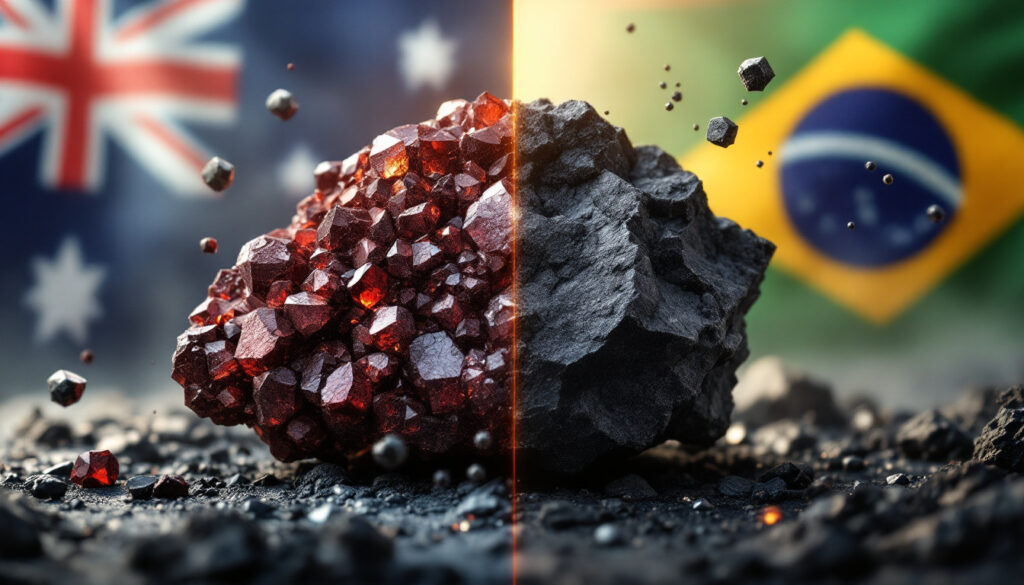What is Iron Ore?
Iron ore stands as the foundation of modern infrastructure, serving as the primary raw material in steel production worldwide. This vital commodity comes in several varieties, each offering unique advantages for mining companies and steel manufacturers. While hematite and magnetite dominate the market, other minerals including goethite, limonite, and siderite also contribute significantly to global iron supplies.
Global iron ore production reached 2.5 billion metric tons in 2024, with Australia (37%) and Brazil (17%) leading output in the international market. The steel industry accounts for approximately 98% of iron ore demand, driven primarily by construction and automotive sectors.
Key Iron Ore Minerals
- Hematite (Fe₂O₃) – Contains 70% iron in pure form
- Magnetite (Fe₃O₄) – Contains 72.4% iron in pure form
- Goethite – A hydrated iron oxide with variable iron content
- Limonite – A mixture of hydrated iron oxide-hydroxide minerals
- Siderite – Iron carbonate mineral with lower iron content
What is Hematite Ore?
Hematite, often referred to as direct-shipping ore (DSO), represents the most commercially valuable types of iron ore hematite vs. magnetite in today's market. Its naturally high iron content and simplified processing requirements make it highly sought after by steel producers worldwide.
Pure hematite contains 70% iron by weight, though mined grades typically average between 55-65% due to natural impurities. Australia exports approximately 880 million tons annually, primarily consisting of hematite from the extensive Hamersley Range deposits.
Hematite Composition and Properties
- Chemical formula: Fe₂O₃
- Contains approximately 70% iron in pure form
- Typically requires minimal processing (crushing, screening, and blending)
- Direct-shipping quality makes it highly desirable for steelmaking
- Hematite's flotation process uses silicates as gangue depressants to achieve industrial-grade concentrates
Major Hematite Mining Regions
- Australia's Hamersley Range in Western Australia – holds approximately 53 billion tons of reserves
- Brazil's Iron Quadrangle and Carajás mine – output dropping to 330 million tons/year in 2024
- China's Tung-Yeh-Chen and Dongye deposits
- India's major iron ore belts in Odisha, Jharkhand, and Karnataka
Leading Hematite Producers
- BHP operates multiple mining and processing hubs in Western Australia, generating $28 billion annually in iron ore revenue
- Rio Tinto's operations include the Hope Downs iron ore complex (50/50 joint venture with Hancock Prospecting)
- Vale operates the Carajás mine in Brazil, the world's largest iron ore mine, which reuses 90% of water in processing
- Various Chinese mining companies in domestic operations
What is Magnetite Ore?
Magnetite ore presents a fascinating contrast to hematite. While containing a higher theoretical iron content, it typically occurs in lower concentrations within rock formations and requires substantially more processing to prepare for steel production.
"Magnetite processing increases energy use by 30-40% compared to hematite, but yields pellets with less than 2% silica content," creating superior quality steel products for specialized applications.
Magnetite Composition and Properties
- Chemical formula: Fe₃O₄
- Contains approximately 72.4% iron in pure form
- Highly magnetic properties (crucial for separation processes)
- Requires concentration before use in steelmaking
- Results in higher-quality end products with fewer impurities
- Superconducting magnets in modern separation techniques achieve 99.5% purity in magnetite concentrates
Processing Requirements for Magnetite
- Concentration through magnetic separation technology
- Pelletizing to prepare for blast furnace use
- Higher processing costs compared to hematite ($50-70/ton vs. $20-30/ton)
- Induration process that oxidizes magnetite to hematite during pellet production
- Magnetite pelletizing produces 0.25 tons of CO₂ per ton compared to hematite's 0.1 tons
Major Magnetite Mining Regions
- Minnesota's Mesabi Range in the United States – home to the historic "Iron Range"
- Michigan's Marquette Range in the United States
- Eastern Canada's taconite deposits
- Labrador Trough in Québec and Newfoundland and Labrador – contains approximately 20 billion tons of magnetite
Leading Magnetite Producers
- Cleveland-Cliffs operates the Hibbing Taconite joint venture in Minnesota's Mesabi Range, producing 7 million tons of magnetite pellets annually
- Various Canadian mining companies focused on the Labrador Trough
- Emerging producers in Western Australia's magnetite belt
How Do Hematite and Magnetite Compare?
The fundamental differences between these two iron ore types extend beyond their chemical formulas, affecting everything from mining methods to steel quality and environmental impact.
Iron Content Comparison
- Pure magnetite: 72.4% iron (theoretical maximum)
- Pure hematite: 70% iron (theoretical maximum)
- Natural deposits often contain impurities that affect actual iron content
- Mined hematite grades typically range from 55-65%
- Mined magnetite concentrations often require upgrading from 25-40% to usable levels
Processing Requirements
- Hematite: Simple crushing, screening, and blending – minimal energy inputs
- Magnetite: Concentration, magnetic separation, and pelletizing – energy-intensive
- Processing costs: Magnetite averages $50-70/ton vs. hematite's $20-30/ton
- Water requirements significantly higher for magnetite beneficiation
End Product Quality
- Magnetite-derived products: Higher quality with fewer impurities
- Hematite-derived products: Good quality but may contain more impurities
- Steel from magnetite pellets has 10-15% higher tensile strength
- Magnetite pellets produce steel with lower phosphorus and sulfur content
Economic Considerations
- Hematite: Lower processing costs but declining high-grade reserves globally
- Magnetite: Higher processing costs but potentially superior end products
- Regional availability affects shipping costs and economic viability
- Companies with integrated mining-pelletizing infrastructure better positioned to weather iron ore price volatility and market strategies
What Are the Environmental Implications?
The environmental footprint of iron ore production varies significantly between hematite and magnetite operations, with important implications for sustainability metrics and regulatory compliance.
Carbon Footprint Considerations
- Magnetite processing emits 2.5 times more CO₂ than hematite processing
- Energy requirements for concentration and pelletizing significantly increase emissions
- EU carbon tariffs increasingly affect valuation of high-emission operations
- Global Steel Climate Council's 2025 emission standards create compliance challenges
Waste Management
- Magnetite processing produces different waste streams that require specialized management
- Hematite mining typically generates less processing waste but more mine tailings
- Water usage for magnetite beneficiation can exceed 4,000 liters per ton
- Modern operations increasingly implement water recycling and waste reduction technologies as part of mining industry decarbonisation efforts
How to Invest in Iron Ore?
Understanding the nuances between iron ore types provides valuable insights for investors seeking exposure to this foundational commodity market.
Major Iron Ore Companies
- BHP (ASX:BHP, LSE:BHP, NYSE:BHP) – primarily hematite operations
- Rio Tinto (ASX:RIO, LSE:RIO, NYSE:RIO) – diversified across ore types
- Vale (NYSE:VALE) – operates world's largest iron ore mine at Carajás
- Cleveland-Cliffs (NYSE:CLF) – focused on magnetite/taconite operations
Investment Considerations
- Global iron ore demand trends driven by infrastructure development and steel consumption
- Price differentials between high-grade and low-grade ores widening with environmental regulations
- Processing capabilities of mining companies affect operational resilience
- Regional production advantages and challenges impact profitability
- ESG risks: Magnetite's higher carbon footprint may affect valuations under carbon pricing schemes
Furthermore, understanding Australia's iron ore price outlook and Australia's clean energy revolution in mining provide additional context for investment decisions. Investors should also consider the geological factors and economic ore deposits and exploration insights that affect iron ore mining viability.
FAQs About Iron Ore Types
What makes magnetite ore different from hematite ore?
Magnetite ore contains higher theoretical iron content (72.4% vs. 70%) but typically requires more processing due to lower natural concentrations and more impurities. Its magnetic properties aid in separation and processing, while the final product often contains fewer impurities than hematite-derived steel.
Why is hematite called "direct-shipping ore"?
Hematite is called direct-shipping ore because its naturally high iron content allows it to be crushed, screened, and shipped directly to steel mills without complex concentration processes. This significantly reduces processing costs and energy requirements compared to magnetite.
Which type of iron ore produces higher quality steel?
Processed magnetite ore typically produces higher quality steel with fewer impurities than hematite ore, though the processing costs are higher. Steel produced from magnetite pellets demonstrates 10-15% higher tensile strength and contains lower levels of problematic elements like phosphorus and sulfur.
Where are the world's largest hematite deposits located?
The world's largest hematite deposits are found in Australia's Hamersley Range, Brazil's Carajás region, and parts of China and India. Australia holds approximately 53 billion tons of economically viable hematite reserves, making it the dominant global supplier.
How does pelletizing improve magnetite ore usability?
Pelletizing agglomerates fine iron ore particles into balls that can be fed into blast furnaces, improving permeability and reducing dust. The induration process also oxidizes magnetite to hematite, enhancing its properties for steelmaking. Modern pelletizing plants achieve uniform size distribution and physical characteristics that optimize blast furnace efficiency.
Looking to Invest in the Iron Ore Market?
Discover real-time alerts on significant ASX mineral discoveries, including iron ore, through Discovery Alert's proprietary Discovery IQ model which transforms complex mineral data into actionable investment insights. Explore why major mineral discoveries can lead to substantial returns by visiting the Discovery Alert discoveries page and position yourself ahead of the market.




